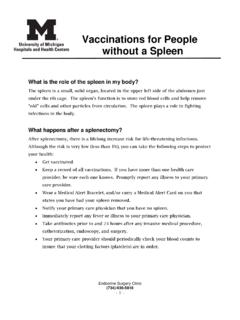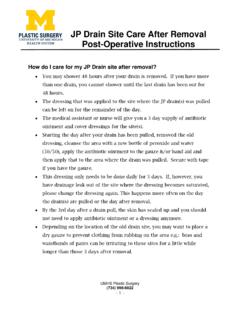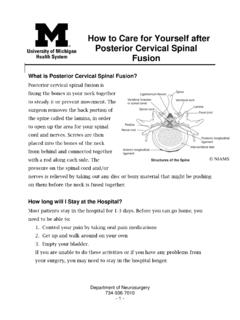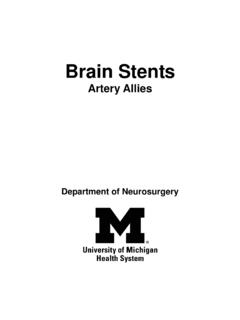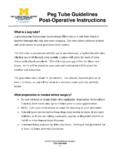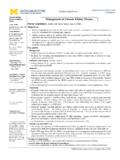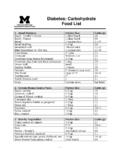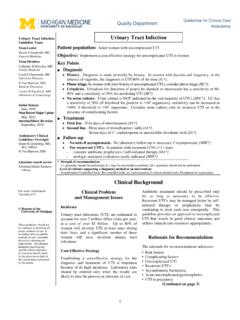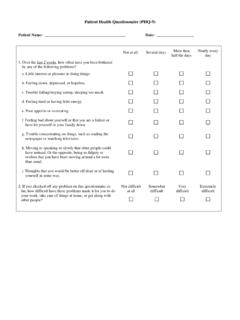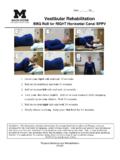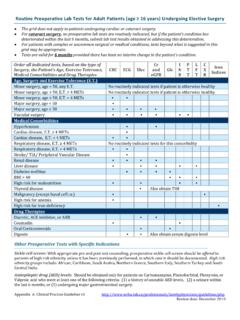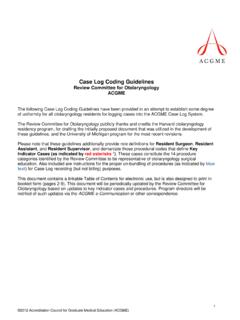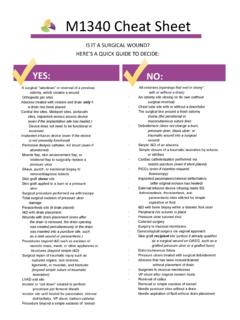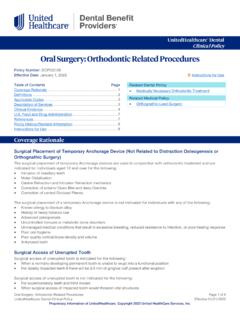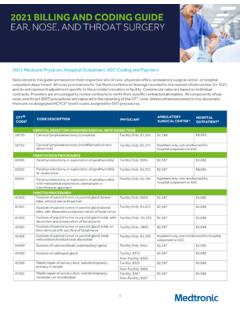Transcription of SURGICAL ANTIMICROBIAL PROPHYLAXIS …
1 SURGICAL ANTIMICROBIAL PROPHYLAXIS RECOMMENDATIONS I. TABLE OF CONTENTS Introduction & Considerations Introduction Considerations Dosing and Re-dosing Guidelines Patients >50 kg (Adult and Pediatric) Patients 50 kg (Adult and Pediatric) SURGICAL ANTIMICROBIAL PROPHYLAXIS Guidelines by Procedure Breast and Axillary Cardiothoracic Gastrointestinal Genitourinary Head and Neck Neurosurgical Obstetrical and Gynecological Ophthalmic Orthopedic Plastic surgery Radiology Solid Organ Transplant Thoracic (non-cardiac) Vascular Footnotes & References Footnotes References Table of Contents Page 2 of 41 II. INTRODUCTION The use of peri-operative antimicrobials has become an essential component of the standard of care for certain SURGICAL procedures and can result in a reduced risk of post-operative infection when sound and appropriate principles are utilized.
2 However, the benefit of ANTIMICROBIAL PROPHYLAXIS must be weighed against the risks of toxic and allergic reactions, emergence of resistant bacteria, drug interactions, super-infection, and cost. III. CONSIDERATIONS FOR ANTIMICROBIAL PROPHYLAXIS Goal: Administer ANTIMICROBIAL PROPHYLAXIS to achieve serum and tissue levels of ANTIMICROBIAL at the time of incision and for the duration of the operation, that are in excess of the minimum inhibitory concentration (MIC) needed for organisms that may be encountered during the procedure. a. ANTIMICROBIAL PROPHYLAXIS should be administered if there is a risk of infection in the absence of a prophylactic agent; clean procedures rarely require PROPHYLAXIS unless high risk procedure, including implantation of prosthetic material. i. Clean procedures are defined as those with no acute inflammation or transection of gastrointestinal, oropharyngeal, genitourinary, biliary, or respiratory tracts (elective cases, no technique break).
3 B. The activity of the chosen prophylactic agent(s) should encompass the most common pathogens associated with the SURGICAL procedure and consider local susceptibility data, but need not cover every likely pathogen. c. The prophylactic agent must be administered in a dose which provides an effective tissue concentration prior to incision / intra-operative bacterial contamination. i. In most instances, a single intravenous dose of an ANTIMICROBIAL agent provides adequate tissue concentrations around the time of anesthesia induction and throughout the operation. 1. ANTIMICROBIAL agent infusion should begin 15-60 minutes before the incision with the exception of vancomycin, levofloxacin, ciprofloxacin, gentamicin, azithromycin and fluconazole. These infusions should begin 45-90 minutes before the incision and infused over 60-120 minutes as indicated for adults and pediatrics (See following tables).
4 2. In adult patients, cefazolin (2 g if <120 kg, 3 g if 120 kg) and vancomycin (1 g if <80 kg, g if 80 kg) dosing is based on weight. Adult patients <50 kg should refer to Patients <50 kg (Adult and Pediatric) Dosing recommendations for dosing. Weight-based dosing is recommended for all antibiotics in patients <50 kg. 3. Infusion duration and time to redosing for recommended prophylactic antimicrobials are summarized for adults and pediatrics. 4. All prophylactic antimicrobials should be discontinued after the intra-operative period, unless otherwise specified. a. Data have not supported subsequent doses after SURGICAL closure and may increase the risk of Clostridium difficile and ANTIMICROBIAL resistance. b. A longer duration of antimicrobials may be indicated, if concomitant infection is present at the time of surgery . Table of Contents Page 3 of 41 BREAST AND AXILLARY PROCEDURES Nature of operation Likely pathogens Recommended regimen Alternative regimen Excisional biopsies None Not recommended Not recommended Wire Localized Breast Biopsy, Re-excision lumpectomy, Sentinel (SLN) alone, Lumpectomy & SLN, Axillary Lymph Node Dissection, Mastectomy (Total or Modified Radical) S.
5 Aureus S. epidermidis Adult: Cefazolin OR Cefuroxime Adult: Clindamycin OR Vancomycin Table of Contents Page 4 of 41 CARDIOTHORACIC PROCEDURES Nature of operation Likely pathogens Recommended regimen Alternative regimen Cardiac surgery with implants Aortic grafts Prosthetic valves Deep Hypothermic Circulatory Arrest (DHCA) (Some procedures may be included in SCIP, and appropriate antibiotic selection is linked to hospital reimbursement) S. aureus S. epidermidis gram-negative bacilli Adults: Vancomycin + Cefuroxime Continue post-op for 24-48 hours Vancomycin dosing modification and duration: CrCl >50 mL/min regardless of weight: Vancomycin 1,000 mg IV q12h x3 doses CrCl <50 mL/min and weight <80 kg: Vancomycin 1,000 mg IV q24h x1 dose CrCl <50 mL/min and weight >80 kg: Vancomycin 1,500 mg IV q24h x1 dose Adults: Any allergy to cefuroxime OR high-risk allergy3/contraindication4 to any beta-lactam5: Vancomycin + Gentamicin Continue vancomycin post-op for 24-48 hours; Gentamicin redosing not recommended given decreased excretion following cardiopulmonary bypass Alternative if any allergy to cefuroxime OR high-risk allergy3/contraindication4 to any beta-lactam5: and SCr 2 mg/dL or CrCL <40 mL/min: Vancomycin + Levofloxacin Continue vancomycin post-op for 24-48 hours.
6 Levofloxacin redosing not indicated given long half-life, especially with renal impairment Alternative to vancomycin if true vancomycin allergy (not Red-Man s): Daptomycin Continue post-op for 24-48 hours Pediatrics: Cefazolin Pediatric: Any allergy to cefazolin OR high-risk allergy3/contraindication4 to any beta-lactam5: Clindamycin Table of Contents Page 5 of 41 CARDIOTHORACIC PROCEDURES Cardiac surgery without implants CABG alone (Some procedures may be included in SCIP, and appropriate antibiotic selection is linked to hospital reimbursement) S. aureus S. epidermidis Adults: Vancomycin + Cefuroxime Continue post-op for 24-48 hours Vancomycin dosing modification and duration: CrCl >50 mL/min regardless of weight: Vancomycin 1,000 mg IV q12h x3 doses CrCl <50 mL/min and weight <80 kg: Vancomycin 1,000 mg IV q24h x1 dose CrCl <50 mL/min and weight >80 kg: Vancomycin 1,500 mg IV q24h x1 dose Adults: Any allergy to cefuroxime OR high-risk allergy3/contraindication4 to any beta-lactam5: Vancomycin + Gentamicin Continue vancomycin post-op for 24-48 hours.
7 Gentamicin redosing not recommended given decreased excretion following cardiopulmonary bypass Alternative to gentamicin if SCr 2 mg/dL or CrCL <40 mL/min: Vancomycin + Levofloxacin Levofloxacin redosing not indicated given long half-life, especially with renal impairment Alternative to vancomycin if true vancomycin allergy (not Red-Man s): Daptomycin Continue post-op for 24-48 hours Congenital heart repair procedures requiring an open sternum postoperatively S. aureus S. epidermidis gram-negative bacilli Pediatrics: Cefazolin Pediatric: Any allergy to cefazolin OR high-risk allergy3/contraindication4 to any beta-lactam5: Clindamycin Table of Contents Page 6 of 41 CARDIOTHORACIC PROCEDURES Pacemaker or AICD placement or revision (Some procedures may be included in SCIP, and appropriate antibiotic selection is linked to hospital reimbursement) S.
8 Aureus S. epidermidis Adults: Cefazolin Continue post-op for 24 hours Adult: Any allergy to cefazolin OR high-risk allergy3/contraindication4 to any beta-lactam5 or history of MRSA infection or colonization: Vancomycin Alternative to vancomycin if true vancomycin allergy (not Red-Man s): Daptomycin Continue post-op for 24-48 hours Pediatrics: Cefazolin Pediatric: Any allergy to cefazolin OR high-risk allergy3/contraindication4 to any beta-lactam5: Clindamycin Heart transplant S. aureus S. epidermidis gram-negative bacilli Adults: Vancomycin + Cefuroxime Continue post-op for 48 hours. If definitive cultures are available, continue antibiotics and tailor regimen Vancomycin dosing modification and duration: CrCl >50 mL/min regardless of weight: Vancomycin 1 g IV q12h x3 doses CrCl 50 mL/min and weight 80 kg: Vancomycin 1 g IV q24h x1 dose CrCl 50 mL/min and weight 80 kg: Vancomycin g IV q24h x1 dose Adults: Any allergy to cefuroxime OR high-risk allergy3/contraindication4 to any beta-lactam5: Vancomycin + Levofloxacin Continue post-op for 48 hours.
9 If definitive cultures are available, continue antibiotics and tailor regimen Alternative to vancomycin if true vancomycin allergy (not Red-Man s): Daptomycin Continue post-op for 24-48 hours Pediatrics: Cefazolin Pediatric: Any allergy to cefazolin OR high-risk allergy3/contraindication4 to any beta-lactam5: Clindamycin Table of Contents Page 7 of 41 CARDIOTHORACIC PROCEDURES Left Ventricular Assist Device (LVAD) S. aureus S. epidermidis Candida spp. enteric gram-negatives Adults: Vancomycin + Cefuroxime Vancomycin dosing modification and duration: CrCl >50 mL/min regardless of weight: Vancomycin 1 g IV q12h x3 doses CrCl <50 mL/min and weight <80 kg: Vancomycin 1 g IV q24h x1 dose CrCl < 50ml/min and weight >80 kg: Vancomycin g IV q24h x1 dose Continue vancomycin for 48-hours post-op. Start rifampin 600 mg PO/IV q24h, levofloxacin 500 mg PO/IV q24h and fluconazole 400 mg PO/IV q24h post-procedure and continue for 48 hours from OR or from chest closure in case of delayed chest closure.
10 If definitive cultures are available, continue antibiotics and tailor regimen Adults: Any allergy to cefuroxime OR high-risk allergy3/contraindication4 to any beta-lactam5: Vancomycin + Levofloxacin Continue vancomycin for 48-hours post-op. Start rifampin 600 mg PO/IV q24h, levofloxacin 500 mg PO/IV q24h and fluconazole 400 mg PO/IV q24h post-procedure and continue for 48 hours from OR or from chest closure in case of delayed chest closure. If allergies or intolerances to vancomycin, rifampin or fluconazole, consultation with Infectious Diseases is recommended. If definitive cultures are available, continue antibiotics and tailor regimen Pediatrics: Cefazolin Pediatric: Any allergy to cefazolin OR high-risk allergy3/contraindication4 to any beta-lactam5: Clindamycin Table of Contents Page 8 of 41 GASTROINTESTINAL PROCEDURES Nature of operation Likely pathogens Recommended regimen Alternative regimen Appendectomy (non-perforated) Enteric gram-negative bacilli Enterococci anaerobes (Bacteroides spp.)
